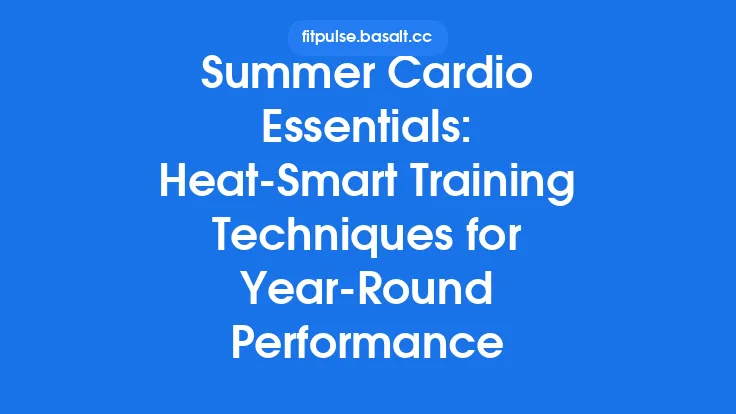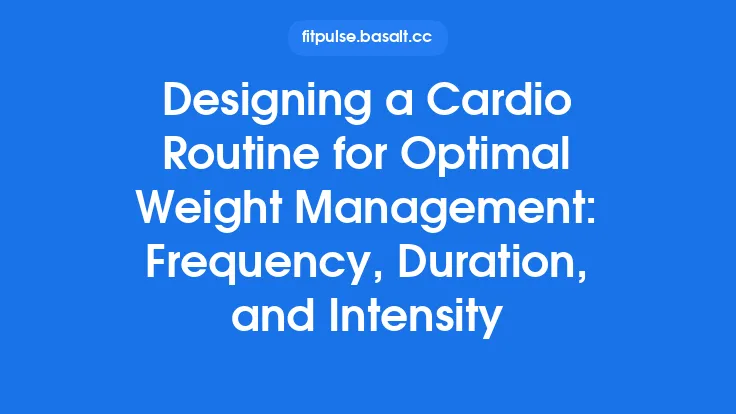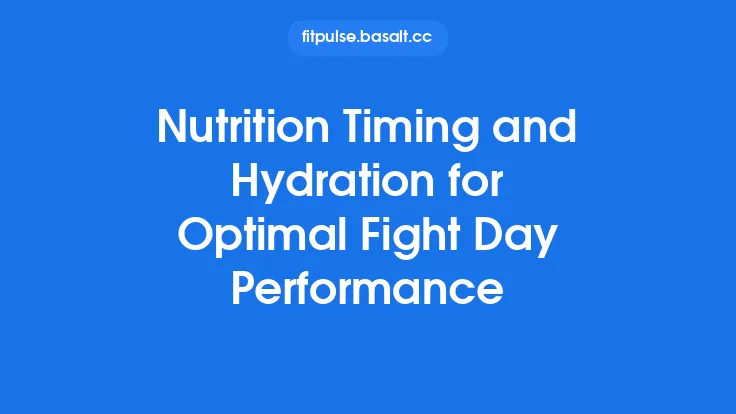Exercising in warm or hot environments presents a unique set of challenges that go beyond the usual demands of training. When ambient temperature rises, the body must work harder to maintain a stable internal temperature, and the balance between heat production and heat loss becomes a critical determinant of performance and safety. Understanding how thermoregulation operates during physical activity, recognizing the signs of heat stress, and applying evidence‑based strategies to mitigate its impact are essential for athletes, coaches, and anyone who trains outdoors or in heated indoor spaces.
Fundamentals of Thermoregulation
The human body maintains its core temperature within a narrow range (≈36.5–37.5 °C) through a sophisticated network of neural, vascular, and endocrine mechanisms. Central thermoreceptors located in the hypothalamus continuously compare the temperature of arterial blood with a set point. When core temperature exceeds this set point, the hypothalamus initiates heat‑dissipating responses; when it falls below, heat‑conserving mechanisms are activated.
Key effectors include:
- Cutaneous vasodilation – widening of skin blood vessels to increase blood flow to the surface, facilitating heat transfer to the environment.
- Sweating – secretion of isotonic fluid onto the skin; subsequent evaporation removes latent heat.
- Behavioral adjustments – changes in posture, activity intensity, or clothing that influence heat exchange.
These processes are tightly regulated by autonomic pathways (sympathetic cholinergic for sweating, sympathetic adrenergic for vasodilation) and modulated by circulating hormones such as antidiuretic hormone (ADH) and aldosterone, which influence fluid balance.
Heat Exchange Mechanisms During Exercise
During physical activity, metabolic heat production can increase up to 20 W kg⁻¹ in high‑intensity efforts. The body relies on four primary routes to dissipate this heat:
- Radiation – emission of infrared energy from the skin to cooler surroundings. Effective when ambient temperature is lower than skin temperature.
- Conduction – direct transfer of heat through contact with cooler objects (e.g., a cold bench). Limited relevance in most outdoor settings.
- Convection – movement of air across the skin surface, carrying away heat. Wind speed and air temperature critically affect convective loss.
- Evaporation – conversion of liquid sweat to vapor, which extracts latent heat. This is the dominant mechanism in hot, low‑humidity environments.
The relative contribution of each pathway shifts with environmental conditions. In humid climates, evaporative cooling is compromised because the air’s capacity to accept additional moisture is reduced, forcing the body to rely more heavily on radiation and convection—both of which may be insufficient when ambient temperature approaches or exceeds skin temperature.
Physiological Responses to Heat Stress
When heat loss cannot keep pace with production, core temperature rises, triggering a cascade of physiological adjustments:
- Cardiovascular drift – progressive increase in heart rate and decrease in stroke volume at a given workload, driven by the need to redirect blood to the skin for cooling. This reduces maximal cardiac output available for muscle perfusion, impairing aerobic capacity.
- Reduced plasma volume – sweating leads to fluid loss; if not replaced, plasma volume contracts, further elevating heart rate and limiting stroke volume.
- Increased perceived exertion – central fatigue mechanisms become more pronounced as the brain integrates thermal signals, often leading to voluntary reduction in intensity.
- Altered neuromuscular function – elevated temperature can affect muscle contractility and nerve conduction velocity, potentially compromising coordination and power output.
If core temperature exceeds ~40 °C, the risk of heat‑related illnesses such as heat exhaustion or heat stroke escalates dramatically. Early signs include profuse sweating, dizziness, nausea, and rapid pulse; heat stroke is characterized by a failure of sweating, a markedly high core temperature, and altered mental status—a medical emergency.
Impact of Environmental Conditions
Two environmental variables dominate heat stress: ambient temperature and relative humidity. The wet‑bulb globe temperature (WBGT) index integrates temperature, humidity, wind speed, and solar radiation into a single metric widely used to set safe exposure limits for athletes and workers.
- High temperature, low humidity – favors evaporative cooling but can still overwhelm the system if sweat rates exceed the skin’s capacity to evaporate fluid.
- High temperature, high humidity – severely limits evaporation, leading to rapid core temperature rise even at moderate workloads.
- Wind (air movement) – enhances convective and evaporative heat loss; however, excessive wind can increase respiratory water loss, potentially contributing to dehydration.
- Solar radiation – adds direct radiant heat load, especially in outdoor sports; reflective clothing and shade can mitigate this component.
Understanding the interplay of these factors allows practitioners to anticipate heat stress risk and adjust training plans accordingly.
Acclimatization to Heat
Repeated exposure to warm conditions induces a suite of adaptations that improve heat tolerance, typically developing over 7–14 days of progressive exposure:
- Earlier onset of sweating and increased sweat gland activity, leading to higher sweat rates at a given core temperature.
- More dilute sweat – enhanced reabsorption of sodium and chloride in the sweat ducts, conserving electrolytes.
- Improved plasma volume expansion – up to 10 % increase, supporting stroke volume and cardiac output.
- Reduced heart rate at a given workload – reflecting improved cardiovascular efficiency.
- Enhanced skin blood flow – facilitating heat transfer.
Acclimatization protocols generally involve daily sessions of 60–90 minutes at 60–70 % of maximal aerobic capacity in the target heat, with gradual increases in duration and intensity. A “maintenance” exposure of 2–3 sessions per week is sufficient to preserve adaptations for several weeks.
Hydration and Electrolyte Management
Adequate fluid balance is the cornerstone of heat stress mitigation. Strategies should be individualized based on sweat rate, which can range from 0.5 to 2.5 L h⁻¹ depending on intensity, clothing, and environment.
- Pre‑exercise hydration – aim for a urine specific gravity ≤1.020; ingest 5–10 mL kg⁻¹ of fluid 2–4 hours before activity, followed by 2–3 mL kg⁻¹ 10–20 minutes prior.
- During exercise – replace 150–250 mL of fluid every 15–20 minutes. For sessions exceeding 60 minutes, incorporate electrolytes (≈20–30 mmol L⁻¹ sodium) to offset sweat losses and maintain plasma osmolality.
- Post‑exercise rehydration – consume 1.5 L of fluid for each kilogram of body mass lost, split over the subsequent 4–6 hours, with added carbohydrates (≈30–60 g L⁻¹) if glycogen restoration is also a goal.
Monitoring body mass changes (pre‑ vs. post‑session) provides a practical estimate of fluid deficit. However, athletes should avoid over‑hydration, which can lead to hyponatremia, especially in prolonged low‑intensity activities where sweat sodium losses are modest.
Clothing and Equipment Considerations
Apparel can either facilitate or hinder heat dissipation:
- Fabric choice – lightweight, moisture‑wicking, and breathable materials (e.g., polyester blends) promote sweat evaporation. Avoid heavy, non‑breathable fabrics that trap heat.
- Color – light‑colored clothing reflects solar radiation, reducing radiant heat gain.
- Fit – loose garments increase the air layer between skin and fabric, enhancing convective cooling; however, excessively loose clothing may impede movement.
- Headgear – hats or caps with ventilation reduce heat accumulation at the scalp, a region with high blood flow.
- Footwear – breathable shoes with moisture‑wicking liners help prevent excessive foot sweating, which can affect overall comfort and performance.
In some sports, specialized cooling garments (e.g., phase‑change material vests) are permitted and can provide pre‑cooling benefits.
Cooling Strategies Pre‑, During, and Post‑Exercise
- Pre‑cooling – lowering core temperature before activity creates a larger thermal buffer. Methods include:
- Cold water immersion (CWI) – 10–15 minutes at 10–15 °C for the torso and limbs.
- Ice slurry ingestion – 5–7 g kg⁻¹ of crushed ice mixed with water, consumed 30 minutes before exercise.
- Cooling vests – worn for 20–30 minutes prior to activity.
- Peri‑exercise cooling – applied intermittently during breaks:
- Misting fans – combine water spray with airflow to enhance evaporative loss.
- Cold towels or ice packs placed on the neck, forearms, and groin, where large blood vessels are superficial.
- Cold water dousing – brief dashes of water over the body, especially effective when ambient humidity is low.
- Post‑exercise cooling – accelerates recovery and reduces residual hyperthermia:
- Active recovery in a cool environment – low‑intensity movement promotes continued blood flow while allowing heat loss.
- CWI or contrast water therapy – alternating cold (10–15 °C) and warm (38–40 °C) immersion can aid in thermoregulatory reset.
- Rehydration with cool fluids – helps lower core temperature and restores fluid balance.
The choice of method should align with sport‑specific constraints (e.g., time, equipment availability) and individual tolerance.
Monitoring Core Temperature and Perceived Exertion
Accurate assessment of thermal strain enables timely interventions:
- Core temperature measurement – ingestible telemetric pills provide real‑time gastrointestinal temperature; alternatively, rectal probes are gold‑standard but less practical in field settings.
- Skin temperature sensors – used to calculate mean skin temperature, informing heat exchange calculations.
- Heart rate monitoring – a rising heart rate disproportionate to workload can signal cardiovascular drift.
- Rate of Perceived Exertion (RPE) – subjective scale that often rises earlier than objective markers, serving as an early warning sign.
- Thermal comfort questionnaires – assess subjective heat sensation and can complement physiological data.
Integrating these metrics into a decision‑making algorithm (e.g., pause or modify intensity when core temperature exceeds 38.5 °C or RPE > 15) enhances safety.
Practical Guidelines for Athletes and Coaches
- Plan training sessions during cooler parts of the day (early morning or late evening) when feasible.
- Gradually increase exposure to heat; avoid sudden high‑intensity workouts in hot conditions.
- Implement structured hydration protocols that include electrolyte replacement.
- Use appropriate clothing and consider pre‑cooling when ambient temperature is forecasted to be high.
- Educate athletes on the signs of heat illness and empower them to self‑monitor.
- Establish emergency procedures: have cooling equipment, shade, and medical support readily available.
- Document environmental conditions (WBGT, temperature, humidity) for each session to track cumulative heat load.
Special Populations and Safety Precautions
- Youth athletes – have a higher surface area‑to‑mass ratio, making them more susceptible to rapid heat gain; stricter limits on intensity and duration are advisable.
- Female athletes – menstrual cycle phases can affect thermoregulatory efficiency; monitoring may be warranted.
- Individuals with chronic conditions (e.g., cardiovascular disease, diabetes) may have impaired sweating or altered blood flow; medical clearance and individualized plans are essential.
- High‑altitude training – reduced air density diminishes convective cooling; combined heat and altitude stress requires careful periodization.
Future Directions and Research
Emerging technologies promise to refine heat‑stress management:
- Wearable thermistors and infrared sensors that continuously map skin and core temperature without invasive devices.
- Machine‑learning algorithms that predict heat strain based on real‑time physiological and environmental inputs.
- Novel cooling materials (e.g., hydrogel‑based fabrics) that actively transport heat away from the body.
- Genomic and proteomic profiling to identify individuals with innate heat tolerance or susceptibility, enabling personalized training prescriptions.
Continued interdisciplinary research—spanning physiology, biomechanics, material science, and data analytics—will deepen our understanding of how to optimize performance while safeguarding health in hot environments.
By mastering the principles of thermoregulation, employing evidence‑based cooling and hydration strategies, and respecting individual variability, athletes can maintain high performance even when the temperature climbs. The key lies in proactive planning, vigilant monitoring, and a willingness to adapt training practices to the thermal realities of the environment.





